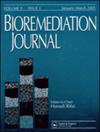硫代硫酸盐生物氧化中硫的回收:本土财团与优势分离物Ochrobactrum sp.。
IF 1.9
4区 环境科学与生态学
Q3 ENVIRONMENTAL SCIENCES
引用次数: 1
摘要
摘要硫代硫酸盐等含硫化合物是对生态系统产生不良影响的污染物之一。硫氧化细菌(SOB)可以将这些化合物代谢成危害较小的产物,如元素硫(S0)。在本研究中,在摇瓶(SF)和1 L搅拌生物反应器(SB),其使用本地SOB联合体。从阿塔什科土壤中提取的原始细胞的富集导致3000个细胞的完全氧化 ppm硫代硫酸盐和14%的S0形成,而原始细胞的氧化率为45%。由于回收了更多的硫(在SF中为30%),选择琼脂糖平板法来保存这种富集的聚集体。3000氧化 SB中的硫代硫酸盐ppm导致35.2%的S0形成,并且与0.2相比,硫代硫酸盐的消耗率明显更高,为1 毫摩尔 S L−1 h−1在SF中。完全氧化更高水平的硫代硫酸盐(4000–6000 ppm),并且S0在6000时回收最多40% ppm硫代硫酸盐。优势菌株经16S rRNA鉴定为Ochrobactrum sp.PN1。尽管该分离物对硫代硫酸盐的氧化与财团非常相似,但S0的形成更高(195 毫克 S L−1)与分离菌株(138 毫克 S L−1)。因此,我们的富集SOB财团能够很好地将硫代硫酸盐部分氧化为S0,这是一种污染较小的中间产品,具有多种用途。本文章由计算机程序翻译,如有差异,请以英文原文为准。
Retrieving sulfur in thiosulfate bio-oxidation: indigenous consortium vs. its dominant isolate Ochrobactrum sp.
Abstract Sulfur compounds such as thiosulfate are among contaminants with undesirable effects on ecosystems. Sulfur-oxidizing bacteria (SOB) can metabolize these compounds into less pernicious products such as elemental sulfur (S0). In this study, products distribution of thiosulfate bio-oxidation with emphasis on S0 was investigated in shake flasks (SFs) and 1 L stirred bioreactor (SB) using an indigenous SOB consortium. Enrichment of original cells taken from Atashkoh soil resulted in complete oxidation of 3000 ppm thiosulfate and 14% S0 formation as compared to 45% oxidation of original cells. The agarose plate method was selected to preserve this enriched-consortium due to the retrieval of more sulfur (30% in SF). Oxidation of 3000 ppm thiosulfate in SB resulted in 35.2% S0 formation and noticeably a higher thiosulfate depletion rate of 1 compared to 0.2 mmol S L−1 h−1 in SF. Complete oxidation of higher levels of thiosulfate (4000–6000 ppm) was achieved in SB and S0 was reclaimed by a maximum of 40% at 6000 ppm thiosulfate. The dominant strain was isolated and identified by 16S rRNA as Ochrobactrum sp. PN1. Although thiosulfate oxidation by this isolate was quite similar to the consortium, S0 formation was higher (195 mg S L−1) by the consortium compared to the isolated strain (138 mg S L−1). Our enriched SOB consortium was therefore well capable of partial oxidation of thiosulfate into S0, a less polluting intermediate product with versatile applications.
求助全文
通过发布文献求助,成功后即可免费获取论文全文。
去求助
来源期刊

Bioremediation Journal
ENVIRONMENTAL SCIENCES-
CiteScore
5.30
自引率
0.00%
发文量
36
审稿时长
9 months
期刊介绍:
Bioremediation Journal is a peer-reviewed quarterly that publishes current, original laboratory and field research in bioremediation, the use of biological and supporting physical treatments to treat contaminated soil and groundwater. The journal rapidly disseminates new information on emerging and maturing bioremediation technologies and integrates scientific research and engineering practices. The authors, editors, and readers are scientists, field engineers, site remediation managers, and regulatory experts from the academic, industrial, and government sectors worldwide.
High-quality, original articles make up the primary content. Other contributions are technical notes, short communications, and occasional invited review articles.
 求助内容:
求助内容: 应助结果提醒方式:
应助结果提醒方式:


